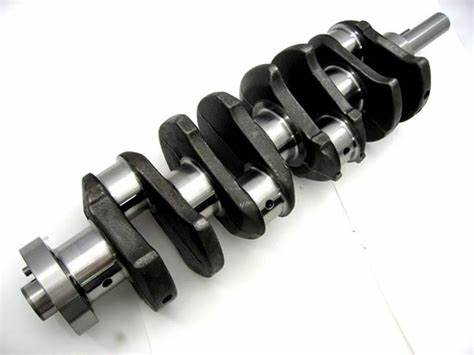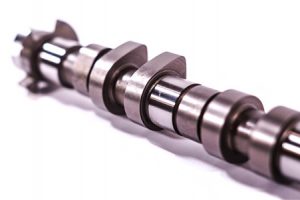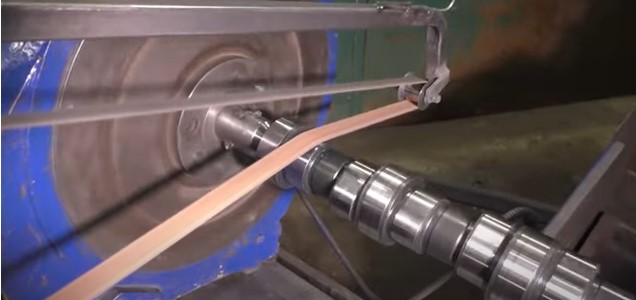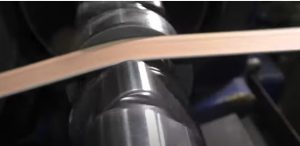Why do crankshafts/camshafts need polishing?
Crankshaft
Engine is to convert chemical energy into mechanical energy of the machine, by burning fuel in the cylinder, kinetic energy, driving the piston reciprocating motion inside the engine cylinder, it will connect on the piston connecting rod and the crank and connecting rod, crankshaft center around a circular motion of reciprocating, crankshaft rotation, crankshaft and flywheel connection, flywheel and transmission links, In this way, power is transferred from the crankshaft to the gearbox, from the gearbox to the half shaft, and from the half shaft to the wheels to output power.
Crankshafts are generally composed of spindle and connecting rod journals. Crank, balance block, front and back end, etc., the material is made of carbon structural steel or nodular cast iron. A spindle neck, a connecting rod diameter and a crank constitute a crank, the number of in-line engine crankshaft crank is equal to the number of cylinders; The number of bends in a V-engine is equal to half the number of cylinders.
Crankshaft processing technology:
blank → drilling →CNC processing → grinding machine coarse grinding → polishing machine polishing.
Camshaft
The function of the camshaft is to control the opening and closing of the valve. Through the continuous rotation of the camshaft, the valve top rod is pushed up and down to control the opening and closing of the valve. Camshaft includes supporting journal, intake and exhaust cams, eccentric wheel, gear driving engine auxiliary device and timing gear journal and other parts. The egg-shaped side of the CAM is designed to ensure adequate intake and exhaust
of the cylinder, specifically to complete the opening and closing of the valve in the shortest possible time. Itsmaterials are cold cast iron, quenchable low alloy cast iron, nodular cast iron, medium carbon steel, carburizing steel, etc.Camshaft rigidity is poor, easy to deform; High precision, difficult processing.
Camshaft main processing procedure is: blank →CNC lathe →CNC milling machine → deburring → quenching, tempering → straighter → fine grinding CAM → fine grinding supporting axis diameter → polishing machine sand belt polishing.
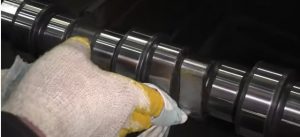
Why do you need polishing?
Friction loss of gas distribution system is the engine internal friction of the three major factors, accounted for 7% ~ 10% of engine friction loss among them, the largest component of piston friction loss; crankshaft system With oil in the engine, the engine operation, the oil will be in the form a layer of oil film on the surface of each component in the engine, can avoid direct contact with the various components of friction Crankshaft after grinding and polishing, the surface will still remain some grinding crack, surface roughness Ra ,Rz, Rvk, Rpk numerical not ideal, such as contour support rate (Rmr) on the low side, and load on the surface of the crankshaft oil effect is poor, as shown in figure 3, the contact surface is stable oil film formation, easy to cause abnormal wear of the crankshaft Burns even scrapped.
In order to improve the surface accuracy and dimensional stability of the crankshaft, it is necessary to superfinish and polish the connecting rod journal and thrust surface.
After surface polishing, the lubrication characteristics of the contact surface are required, the geometric size is improved, and a stable lubricating film is formed on the crankshaft surface to evenly transfer the bearing capacity. The traditional process is to use the mould of the stone ultra-finishing machine tool, after processing seriously destroyed the geometric shape of the journal, the formation of saddle shape (concave), and has a great impact on the size of the journal of the crankshaft ultra-finishing has long used CNC sand belt polishing process, and this grinding belt is moisture-proof electrostatic sand (to ensure that the sand tip outward). In order to be able to the round corner and shaft shoulder polishing, grinding belt can be processed into toothed belt, in order to fit with the machining surface of the crankshaft grinding belt polishing machine can simultaneously polish the spindle neck connecting rod shaft neck round corner shaft shoulder and thrust surface of the structure are used to clamp, each journal with 4 pads (concave) compaction sand belt; Pad and grinding belt should be selected according to the material and hardness of the workpiece. The winding function on the machine ensures that each journal has a new strip (adjustable length) to work. The polishing method is carried out on the principle of super finishing, and its efficiency and effect are far better than that of whetstone.
Common important parameters of polishing
Surface roughness refers to the roughness of the machining surface with small spacing and small peaks and valleys, which belongs to the microscopic geometric shape error.
4.1 Arithmetic mean of roughness profile Ra (GB/T 3505)
Ra is defined as the arithmetic mean of the absolute value of the Z-direction deviation relative to the mean line in a sampling length. In actual measurement, the more the number of measurement points, the more accurate Ra will be.
Ra is calculated as Ra=1/l ∫t0 | Y(x) | dx
4.2 Maximum contour height Rz
Rz is defined as the sum of the maximum contour peak height and the maximum contour valley depth within a sampling length, as shown in Figure 6.
4.3 Contour Support Length rate Rmr (c)
Rmr (c) is defined as the ratio of the length Ml (c) of the solid material profiled at a given horizontal section height c to the assessed length. Under the same Ra surface accuracy, the higher Rmr (c) is, the more solid materials support the oil film on the micro surface, and the corresponding journal wear resistance is better.
Polishing consumables
With the help of high voltage electrostatic field force, the Moresuperhard electrostatic sand planting belt plants the fine abrasive on the high strength film, so that the abrasive oriented uniform distribution, can provide higher grinding efficiency and bright and detailed mirror effect. Abrasive types include alumina, silicon carbide, diamond, etc., to meet the requirements of different hardness of the workpiece processing.
—EDITOR: Doris Hu
—POST: Doris Hu

